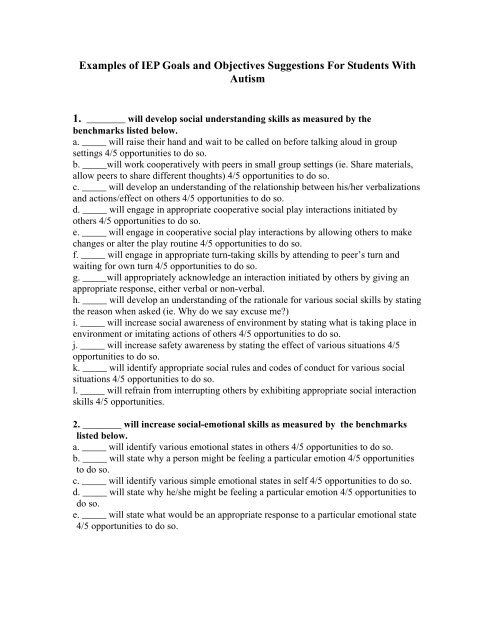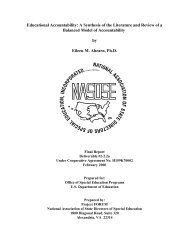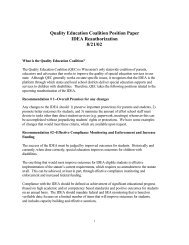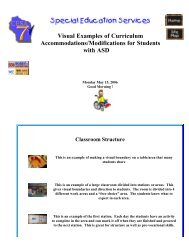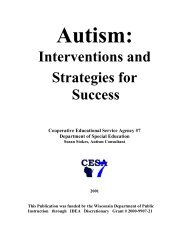IEP Goals and Objectives Suggestions
IEP Goals and Objectives Suggestions
IEP Goals and Objectives Suggestions
Create successful ePaper yourself
Turn your PDF publications into a flip-book with our unique Google optimized e-Paper software.
Examples of <strong>IEP</strong> <strong>Goals</strong> <strong>and</strong> <strong>Objectives</strong> <strong>Suggestions</strong> For Students With<br />
Autism<br />
1. ________ will develop social underst<strong>and</strong>ing skills as measured by the<br />
benchmarks listed below.<br />
a. _____ will raise their h<strong>and</strong> <strong>and</strong> wait to be called on before talking aloud in group<br />
settings 4/5 opportunities to do so.<br />
b. _____will work cooperatively with peers in small group settings (ie. Share materials,<br />
allow peers to share different thoughts) 4/5 opportunities to do so.<br />
c. _____ will develop an underst<strong>and</strong>ing of the relationship between his/her verbalizations<br />
<strong>and</strong> actions/effect on others 4/5 opportunities to do so.<br />
d. _____ will engage in appropriate cooperative social play interactions initiated by<br />
others 4/5 opportunities to do so.<br />
e. _____ will engage in cooperative social play interactions by allowing others to make<br />
changes or alter the play routine 4/5 opportunities to do so.<br />
f. _____ will engage in appropriate turn-taking skills by attending to peer’s turn <strong>and</strong><br />
waiting for own turn 4/5 opportunities to do so.<br />
g. _____will appropriately acknowledge an interaction initiated by others by giving an<br />
appropriate response, either verbal or non-verbal.<br />
h. _____ will develop an underst<strong>and</strong>ing of the rationale for various social skills by stating<br />
the reason when asked (ie. Why do we say excuse me?)<br />
i. _____ will increase social awareness of environment by stating what is taking place in<br />
environment or imitating actions of others 4/5 opportunities to do so.<br />
j. _____ will increase safety awareness by stating the effect of various situations 4/5<br />
opportunities to do so.<br />
k. _____ will identify appropriate social rules <strong>and</strong> codes of conduct for various social<br />
situations 4/5 opportunities to do so.<br />
l. _____ will refrain from interrupting others by exhibiting appropriate social interaction<br />
skills 4/5 opportunities.<br />
2. ________ will increase social-emotional skills as measured by the benchmarks<br />
listed below.<br />
a. _____ will identify various emotional states in others 4/5 opportunities to do so.<br />
b. _____ will state why a person might be feeling a particular emotion 4/5 opportunities<br />
to do so.<br />
c. _____ will identify various simple emotional states in self 4/5 opportunities to do so.<br />
d. _____ will state why he/she might be feeling a particular emotion 4/5 opportunities to<br />
do so.<br />
e. _____ will state what would be an appropriate response to a particular emotional state<br />
4/5 opportunities to do so.
3. _____ will increase social communication skills as measured by the benchmarks<br />
listed below.<br />
a. _____ will initiate communicative interactions with others 4/5 opportunities to do so.<br />
b. _____ will initiate varied appropriate topics with others 4/5 opportunities to do so.<br />
c. _____ will initiate communicative interactions with others by asking questions 4/5<br />
opportunities to do so.<br />
d. _____ will engage in conversational turn-taking with others across 3-4 conversational<br />
turns, 4/5 opportunities to do so (topics initiated by self /others).<br />
e. _____ will call attention to communicative partner prior to communicating 4/5<br />
opportunities to do so.<br />
f. _____ will ask questions of others regarding topics initiated by self or others to sustain<br />
conversation for conversational turn-taking 4/5 opportunities to do so.<br />
g. _____ will identify <strong>and</strong> underst<strong>and</strong> various non-verbal social communication<br />
behaviors (ie. Tone of voice, personal space, vocal volume, body orientation, facial<br />
expressions) by stating their implied meaning 4/5 opportunities to do so.<br />
h. _____ will spontaneously seek assistance/ ask for help/ seek additional information<br />
given visual prompts 4/5 opportunities to do so.<br />
i. _____ will spontaneously use a verbal or non-verbal message to indicate to the speaker<br />
that he needs additional “wait” time to process information editorially 4/5 opportunities<br />
to do so.<br />
j. _____ will identify breakdowns in communication <strong>and</strong> make appropriate adjustments<br />
4/5 opportunities to do so.<br />
4. ____ will increase narrative discourse skills to objective criteria as measured by<br />
the benchmarks listed below.<br />
a. _____ will state the main idea of the story, video or situation 4/5 opportunities to do<br />
so.<br />
b. _____ will relate information (ie. Past events, stories, situations, etc…) sequentially<br />
4/5 opportunities to do so.<br />
c. _____ will identify what happened first, in the middle, <strong>and</strong> last regarding a previous<br />
read story, past event, or situation.<br />
d. When relating information_____ will provide an initial background statement, include<br />
referents, include important pieces of relational information <strong>and</strong> leave out irrelevant<br />
details.<br />
5. ____ will increase their ability to function appropriately within the school<br />
environment as measured by the benchmarks listed below.<br />
a. Given visual <strong>and</strong> verbal prompts, _____ will participate in tasks/ activities to<br />
completion by exhibiting appropriate behaviors, _% of the time.<br />
b. _____ will transition appropriately from tasks <strong>and</strong> activities <strong>and</strong> school environments<br />
_% of the time given visual <strong>and</strong> verbal prompts.<br />
c. _____ will accept changes in routine/schedule by exhibiting appropriate behaviors<br />
given visual <strong>and</strong> verbal cues _ % of the time.<br />
d. _____ will follow classroom rules <strong>and</strong> directives given visual <strong>and</strong> verbal prompts _%<br />
of the time.
e. _____ will independently take a break given visual prompts _ % of the time.<br />
(goal #5: objectives contd.)<br />
f. _____ will independently ask to take a break given visual <strong>and</strong> verbal prompts _% of<br />
the time.<br />
Strategies to focus on above <strong>Goals</strong>/ <strong>Objectives</strong>:<br />
* Social Stories<br />
* Comic Strip Conversations<br />
* Social Scripting/ Computer Conversations (reduces social dem<strong>and</strong>s of situation)<br />
* Find <strong>and</strong> use “hooks” (high interests )for academics, social relations, social<br />
communication, etc…<br />
*Video-tapes<br />
* Digital Photography (for real life situations)<br />
* Audio-taping<br />
* Lunch/Recess Clubs<br />
* Story-mapping (Inspiration Software)<br />
* Individual visual schedule<br />
* Visual directions<br />
Adapted From Susan Stokes, CESA 6 Autism Consultant


